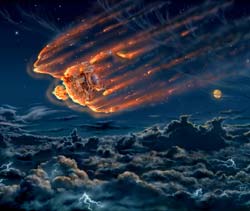Jupiter will vaporize spacecraft

An artist’s impression of Galileo descending into Jupiter. Credit: David A Hardy. www.astroart.org
Galileo, the NASA space probe in which UK scientists have played a key role, will dramatically end its 14-year mission when it plunges into Jupiter’s dense atmosphere on the 21st September. The spacecraft, which has revealed a wealth of scientific data on Jupiter and its moons, with fuel and power exhausted, will vaporize like a meteor as its descends through the giant planet’s turbulent atmosphere (an artist’s impression of what this might look like is available – please see notes to editors).
As well as extensive scientific data, Galileo has provided the most visually stunning images of Jupiter and its moons ever, especially Io and Europa. The probe, launched in 1989 by the Space Shuttle Atlantis, also imaged the Earth, Venus, the Moon and several asteroids during its lifetime.
The highlights of the mission include the identification of massive amounts of lightening activity in Jupiter’s atmosphere, where hurricane-force winds and huge amounts of heat from the interior whip clouds of frozen ammonia into bands that encircle the planet, studded with giant storms, some of them larger than the entire Earth. The planet is richer in heavy elements than the Sun, showing that it was assembled from smaller ’planetesimals’ rather than condensing in isolation as previously surmised.
Galileo also discovered that Jupiter’s rings are made of small dust grains blasted off the surface of Jupiter’s four innermost satellites by the impacts of meteoroids. The infrared spectrometer on Galileo took the surface temperature of Io, one of Jupiter’s moons, and discovered that many of Io’s active volcanoes are much hotter than Earth’s, indicating a higher magnesium or iron content for the silicate lava that erupts from below Io’s surface than would be expected in a terrestrial volcano.
Commenting on the mission, Prof. Ian Halliday, Chief Executive Officer of the Particle Physics and Astronomy Research Council, the UK’s space science agency, said, ” Galileo has been a resounding scientific success. Our understanding of Jupiter and the Jovian system has been increased enormously and UK scientists have been at the forefront of some of these amazing discoveries”.
Galileo images and infrared spectra have revealed that Europa, another Jovian moon, has a salty ocean beneath its cracked and frozen surface, an impression that is reinforced by the lack of craters on the moon, which show the surface to be relatively young. Galileo has revealed that Jupiter’s largest moon, Ganymede, has its own magnetic field and evidence has also been provided to support the existence of a subsurface ocean on Callisto.
Scientists from Oxford University, The Open University and Imperial College are involved in three of the eleven instruments onboard Galileo.
Professor Tony McDonnell from the Planetary and Space Sciences Research Institute (PSSRI) at The Open University is Co-Investigator on the Dust Detector Subsystem which has looked at the properties of dust particles within the Jovian system said,
“Galileo has been a truly remarkable mission. The results from the Dust Detector Subsystem indicate that much of the dust comes from outside the solar system indicating that it originates from distant stars.”
Professor Fred Taylor from Oxford University, a team member for the infrared spectrometer experiment on Galileo, said : “Galileo has provided a fantastic database that will be a rich source of progress in the planetary sciences for years or decades to come. The mission has provided key information about Jupiter and its place in the solar system.”
Dr Michele Dougherty from Imperial College is a team member on the Magnetometer instrument that detects magnetic fields in the spacecraft’s immediate environment. She comments, “It is always sad when a mission comes to the end of its lifetime. However, Galileo has exceeded expectations and provided a wealth of scientific data resulting in the discovery of many new important facts about the Jovian system. In addition the images produced of Europa and Io are stunning.”
The UK scientists are working with their US and other overseas colleagues on a massive, multi-authored book that will record the scientific results of Galileo’s 30-year odyssey and form a fitting epitaph for one of the most successful of man’s voyages to his planetary neighbours so far.
Media Contact
All latest news from the category: Physics and Astronomy
This area deals with the fundamental laws and building blocks of nature and how they interact, the properties and the behavior of matter, and research into space and time and their structures.
innovations-report provides in-depth reports and articles on subjects such as astrophysics, laser technologies, nuclear, quantum, particle and solid-state physics, nanotechnologies, planetary research and findings (Mars, Venus) and developments related to the Hubble Telescope.
Newest articles

Superradiant atoms could push the boundaries of how precisely time can be measured
Superradiant atoms can help us measure time more precisely than ever. In a new study, researchers from the University of Copenhagen present a new method for measuring the time interval,…

Ion thermoelectric conversion devices for near room temperature
The electrode sheet of the thermoelectric device consists of ionic hydrogel, which is sandwiched between the electrodes to form, and the Prussian blue on the electrode undergoes a redox reaction…

Zap Energy achieves 37-million-degree temperatures in a compact device
New publication reports record electron temperatures for a small-scale, sheared-flow-stabilized Z-pinch fusion device. In the nine decades since humans first produced fusion reactions, only a few fusion technologies have demonstrated…





















